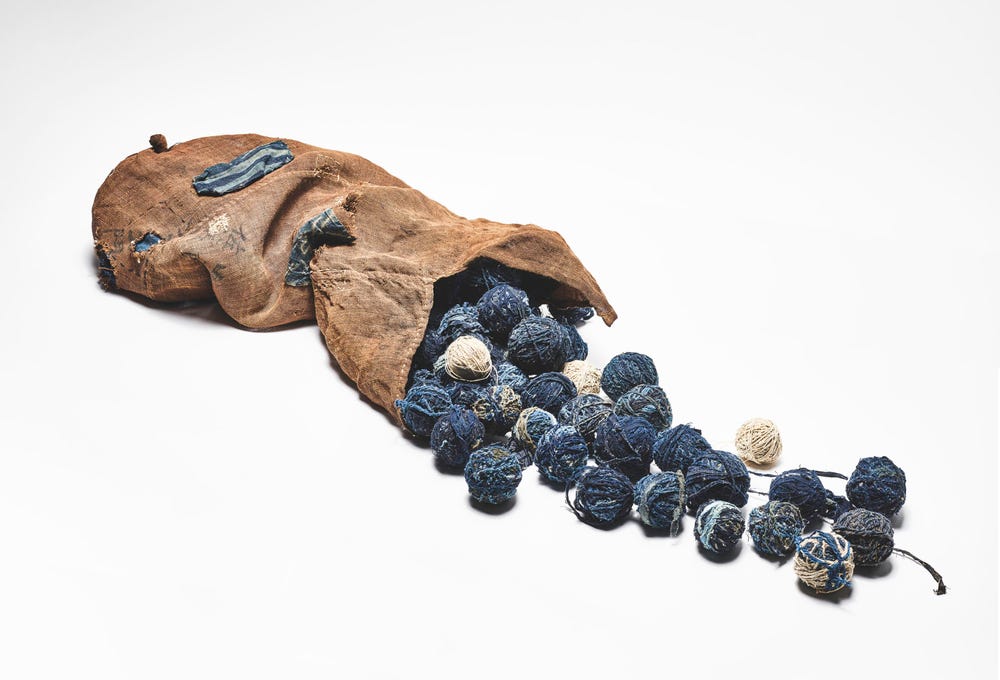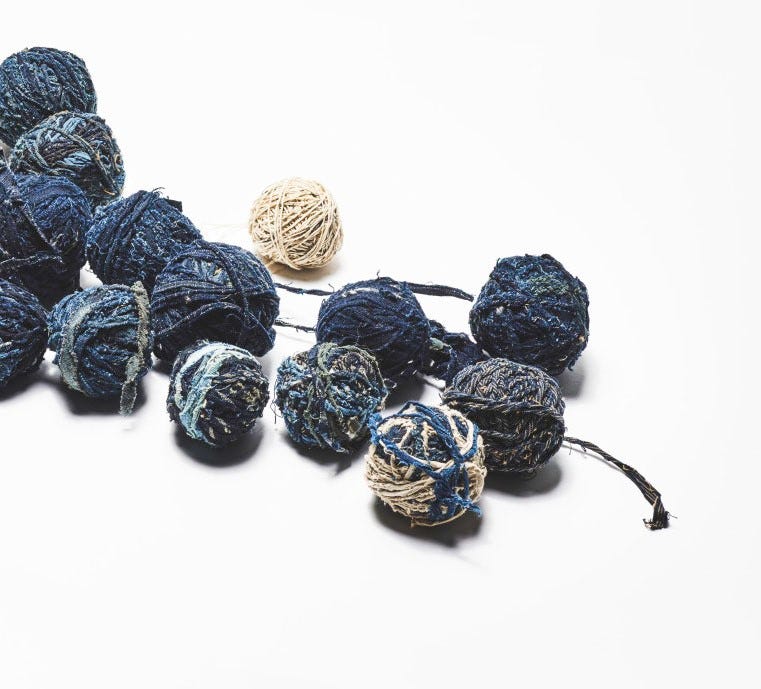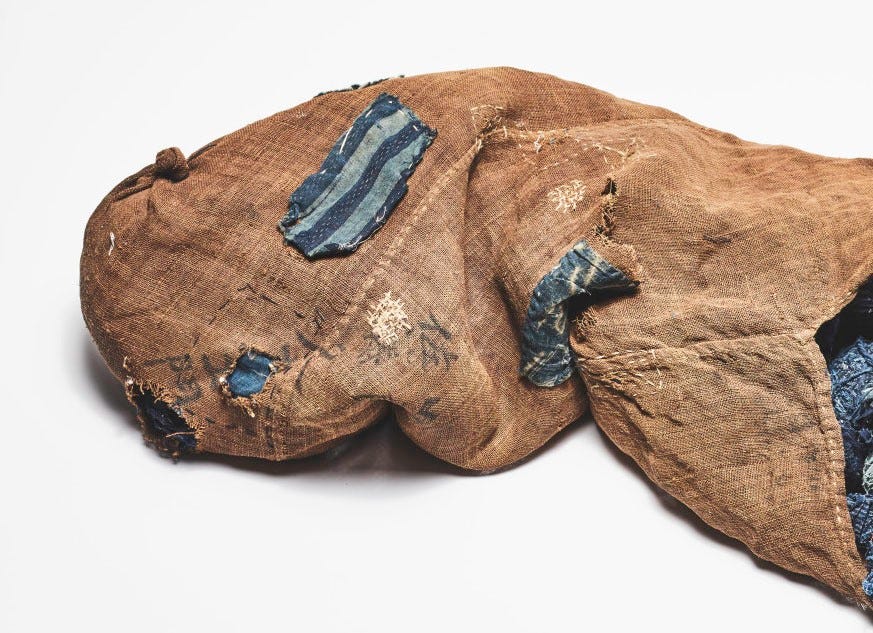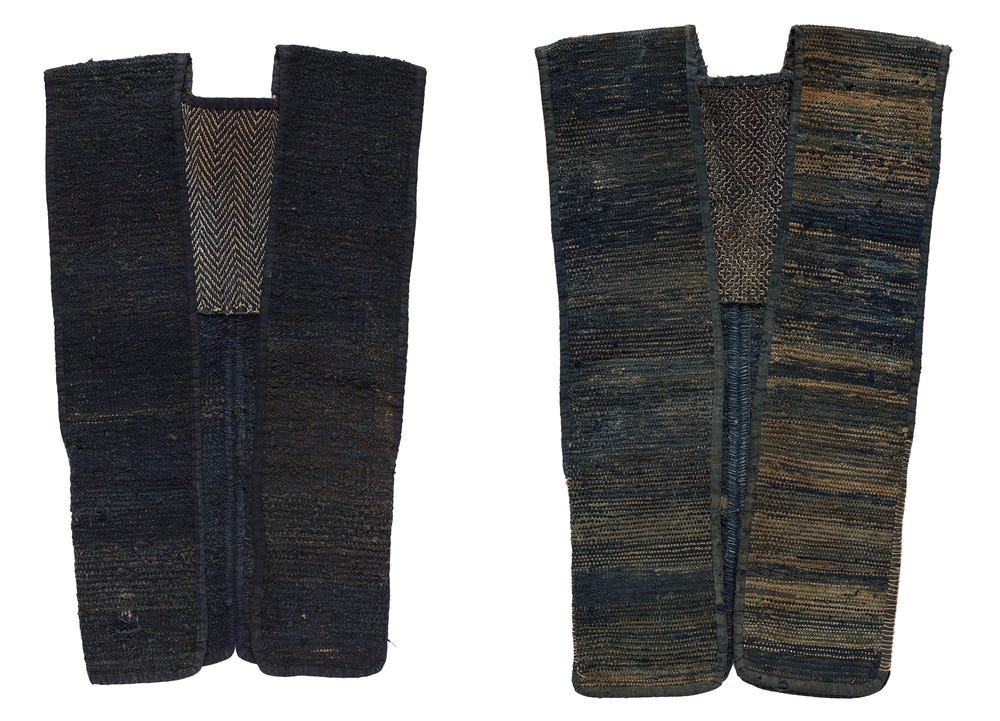The Necessity of Resourcefulness: Lessons from Traditional Japanese Textiles
By Ana Matsubara with Jill D’Alessandro
April 22, 2021
Prior to industrial manufacturing, and the globalization of our economies, many regional craftspeople used environmentally friendly practices out of necessity. Often, craft utilizes local resources and preindustrial tools made from natural materials. Grounded in small-scale networks, and responding to day-to-day human needs, centuries-old craft systems can provide us with much inspiration today.
Rag merchant's bag containing sakiori balls, 1873. Gift of Cynthia Shaver, 2013.44.1. Photograph by Randy Dodson
Held in the FAMSF’s costume and textile arts collection, this rag merchant’s bag offers a window into Japanese history that can teach us valuable lessons about sustainability today. This type of bag is known as tsunobukuro, or horn bag. Although horn bags were typically used to transport grains or beans, this tsunobukoro holds the fabric goods of a rag merchant. The bag is constructed from a single length of cloth that is stitched along the bias. This construction conserves material and also allows the bag to stretch. The resulting “horns” at the bag’s opening can be conveniently tied closed or used as handles to carry the bag. The substantial stitching and patching on the surface of the bag indicate that it was likely reused, and repaired, extensively. Before cotton became widely available in Japan, tsunobukoro were constructed of fabrics woven with materials from native plants and trees. This particular bag is woven with fibers from a linden tree. The bag contains 97 balls of yarn made from ripped cotton rag and twisted recycled paper. It originated in the Akita prefecture of the Tohoku region in 1873. The surface is marked “Meiji, Akita, March 6” in sumi ink.
Detail of sakiori balls, 1873. Gift of Cynthia Shaver. Photograph by Randy Dodson
In 2013, Cynthia Shaver, a Bay Area–based Asian-art appraiser, donated the bag to the Museums’ collection. Shaver was first introduced to the bag in 2011, at an exhibition titled Mottainai: The Fabric of Life Lessons in Frugality from Traditional Japan, hosted by the Japanese Garden Society of Oregon. The exhibition was organized by Japanese-textile gallery owners Kei Kawasaki of Gallery Kei in Kyoto and Stephen Szcepanak of Sri in Brooklyn, and featured folk garments and fabrics constructed from plant fibers, and patchwork cloths from rural communities in Japan. In our recent interview, Shaver shared that the linden bag, placed at the center of the exhibition, struck her as a clear symbol of old and new—it provided a snapshot of the important transition from traditional indigenous fibers to cotton. She further noted that had the bag been made just twenty years later, it would have been constructed of imported cotton rather than the tree fiber.
For most of Japan’s history, textiles were woven from the fibers of indigenous plants and trees categorized as “bast fibers.” They were derived from trees and plants such as linden, paper mulberry, elm, wisteria, hemp, ramie, and banana fiber.1 The time- and labor-intensive work of collecting and processing fibers for weaving was mostly done by women. Due to Japan’s diverse range of climates, and the variety of plant life each climate sustained, textile traditions varied from region to region. In the southern subtropical climate of Okinawa, banana fiber, known as Basho-fu, was popular for its fine and glossy appearance.2 In the northern temperate region of Tohoku, the linden tree was foraged for its fibers.3 To extract fibers from the linden tree, its outer bark and its wood are separated to reveal an inner layer of fibers. These fibers are peeled and removed, then boiled in ash and fermented.4 Linden fibers were woven into cloth for garments, mosquito nets, and bags such as the linden bag.5 The texture is more coarse than other bast fibers and, unlike cloth woven from wisteria or elm, it doesn’t soften over time with use. These fibers were not particularly comfortable, or protective against harsh winters, especially in the cold northern climates. The introduction of cotton was a welcome innovation to these regions.
Detail of rag merchant bag, 1873. Gift of Cynthia Shaver. Photograph by Randy Dodson
Cotton is a crop that is not native to Japan. It was introduced from China and Korea around 600 CE but wasn’t widely cultivated until the sixteenth century.6 Until the nineteenth century, cotton was a luxury that most common people couldn’t afford. The crop was grown and processed in the southern and western regions, where the warmer climate could support farming it. Unable to produce their own cotton, northern regions depended on the trade of cotton fabrics from the south. Trade occurred through the Kitamae Bune, a shipping route that traversed the ports of the western coast of Japan during the Edo (1603–1868) and Meiji periods (1868–1912).7 Due to cotton’s scarcity, cotton pieces were rarely thrown away. Cotton fabrics were traded in the form of scraps, garment fragments, and fabric lengths. These coveted pieces were sold directly at the ports, or by rag merchants who would collect scrap fabrics, pack them into horn bags such as this one, and peddle them throughout neighboring villages. Often, multiple families would collectively purchase a bag of scrap cotton and divide the pieces among themselves. These worn pieces would be used to mend or create new textiles and garments.
Scrap fabrics found new life through time-intensive mending and weaving techniques like boro and sakiori. Boro refers to a patchwork style of textile-making that utilizes scrap fabrics of all materials and sizes. As Japanese textile scholar Yoshiko Wada explains, “the Japanese term boro refers to objects that have been used, broken, and worn to tatters, then mended extensively and lovingly used far beyond their normal expected life cycle.”8 Over time, as fabrics are continuously mended and stitched, the patches overlap and intensify into a complex layering of textures. Today, boro is experiencing a resurgence as Japanese brands like Kapital and Koromo produce expensive and coveted boro garments.
Long cotton strands, also known as rag yarn, would have been woven into sakiori. According to Shaver, rag yarn was sourced from the fabric of worn kimono. Lengths of kimono fabric were torn into strips by hand to create long, thin strands for weaving. It’s important to note that Japanese kimono are constructed entirely of rectangular lengths of cloth. Through folding and tying, shapes and silhouettes are created without producing excess waste. This minimalist design structure allows for simple recycling processes as entire rectangular cloths of kimono can be torn into lines of rag yarn.
Vests (sodenashi), late 19th century Japan 2013.44.2; 2013.44.3. Gift of Cynthia Shaver in honor of Mary Olive
“Saki” comes from the Japanese verb saku, meaning to tear or cut, while “ori” comes from the verb oru, to weave.9 Rag yarn would be woven as a weft with a bast fiber or cotton as a warp. The contents in the rag merchant’s bag would have provided ample materials to weave sakiori textiles. This method of weaving produced durable and thick textiles that provided sturdy protection against the elements. Sakiori textiles were used to create coats, jackets, aprons, and other garments such as the two vests, meant to be worn for outdoor work, in the Museums’ collection. Because of its durability, sakiori was common workwear for farmers, lumbermen, fishermen, and other outdoor laborers.10 These garments would be worn out until they were further transformed into new pieces.
This long history of reusing materials exemplifies the Japanese notion of mottainai that headlined the 2011 exhibition Mottainai: The Fabric of Life: Lessons in Frugality from Traditional Japan organized by the Japanese Garden Society of Oregon. The phrase translates roughly to “waste nothing.” It’s still a common exclamation today that could be used to scold a child into eating the rest of their dinner or to save the wrapping paper from a gift. For many Japanese who grew up in less affluent times, this phrase is not easily forgotten. Prior to the economic boom of the late 1900s, Japan was not a wealthy country.11 People made do with limited resources by preserving what they had. Recycling was an essential mechanism for survival.
In the accompanying text for the collection, curator Diane Durston wrote:
"Mottai was originally a Buddhist term that referred to the “essence of things.” Applied to everything in our physical universe, the word suggests that objects do not live in isolation but are intrinsically linked to one another. “Nai” is a negation, so “mottainai” is an expression of sadness for the disrespect that is shown when any living or nonliving entity is wasted."12
This notion of respect toward things is framed within the personal and economic necessity of frugality, but it can also serve us as a global concept to address the negative impacts of mass production and hyper-consumption today. In the current era of two-day shipping and mega sales, the allure of newness and the cutting edge is always around the corner. When we take time to care for the things we already have, by mending or recycling our belongings, we can reimagine our ecological and ethical relationship with consumption through a more sustainable framework.
1 Japanese Garden Society, 4.
2 Ibid., 22.
3 Ibid., 10.
4 Ibid., 4.
5 Japanese Garden Association, 10.
6 Japan Society NYC.
7 Ibid.
8 Iwamoto Wada
9 Yoshida, 3.
10 Ibid
11 Japanese Garden Society, 2.
12 Ibid
Credits
A thank you to Cynthia Shaver.
This rag merchant’s bag is one of several donations from Shaver’s collection of Japanese textiles. Shaver is a longtime member of the FAMSF, supporter of the textile arts department, and a former Textile Arts Council board member.
Ana Matsubara is a third-year design student at the University of Southern California and an intern in the Caroline and H. McCoy Department of Textile Arts. Matsubara is interested in the intersection of design and sustainability, which she explores through her ongoing natural-dye and clothing project, dai-dai.
Works Cited
Yoshida, Shin-ichiro. Riches from Rags: Saki-Ori & Other Recycling Traditions in Japanese Rural Clothing. San Francisco Craft & Folk Art Museum, 1994.
Japan Society NYC, “Boro Textiles: Sustainable Aesthetics - Video Tour Part 2.” Published April 13, 2020. https://www.youtube.com/watch?v=k7WKS3oQS8M
Japanese Garden Society of Oregon, and Diane Durston. Mottainai: The Fabric of Life: Lessons in Frugality from Traditional Japan. Portland, OR: Gallery Kei & Sri at Portland Japanese Garden, 2011.
Iwamoto Wada, Yoshiko. “Japanese Boro: A New Way to See Beauty.” In Ragged Beauty: Repair and Reuse, Past and Present. San Francisco Craft & Folk Art Museum, 2004. https://yoshikowada.files.wordpress.com/2018/01/vav-32-35-boro-by-wada.pdf







